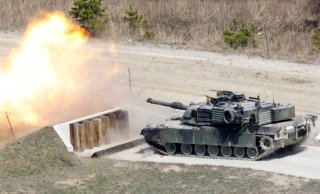A Tremendous Tank Arsenal Could Prevent Future Wars
Tanks are so effective at deterring conflict they do not even need to be in the fray.
Here's What You Need to Know: Heavy ground forces are best at deterring war and boosting a country’s overall influence in the aftermath of a crisis.
Heavy ground forces are best at deterring war and boosting a country’s overall influence in the aftermath of a crisis.
But the heavy forces, which include armored vehicles such as tanks plus artillery and air-defense systems, merely should be near a conflict zone, not in it.
That’s the conclusion of a February 2020 study by RAND, a California think tank with close ties to the U.S. military.
The RAND report underscores the wisdom of the U.S. Army’s efforts permanently to station more heavy forces in Europe. By the same token, the study is a reminder that the United States’ conventional deterrence in Europe might still be inadequate even after current reinforcements are in place.
“The results of the analysis provide consistent evidence for the deterrent effects of heavy ground forces and air-defense capabilities,” RAND explained, “especially when deployed in the general theater of interest but not necessarily on the front lines of a potential conflict.”
“The more mobile forces are, the less evidence there is that they deter,” RAND added. “This is possibly because mobile forces represent a lesser degree of high-level or long-term U.S. commitment or possibly because measuring their effects is more difficult.”
But in order to balance deterrence against provocation, ground forces should make their bases in countries neighboring the countries where war is mostly likely to break out. “When U.S. forces, particularly light ground forces, are stationed inside the borders of the ally or partner to be defended rather than in nearby states in the broader theater, they are associated with an
increased likelihood of militarized disputes,” RAND pointed out.
So-called “crisis deployments” -- in other words, deploying troops on short notice in direct response to an imminent military threat -- can stop a war from breaking out but tend to leave the deploying country no better off than it was before, RAND found.
Strategically speaking, it’s more advantageous for the defender to keep heavy forces on a permanent basis near the conflict zone, according to the think tank.
RAND’s findings are consistent with other studies the Army’s recent experience.
For decades the Army maintained heavy forces in Europe in order to defend against the Soviet Union and later Russia. Force levels precipitously decreased following the end of the Cold War, but as late as 2012 the Army had four brigades in Europe, two of them with tanks.
The administration of Pres. Barack Obama cut the two Europe-based tank brigades in the wake of the 2011 debt-ceiling squabble with Congress that resulted in the Budget Control Act and automatic "sequestration" budget cuts. Army troops permanently in Europe declined from 40,000 to around 25,000.
Soon an Army regiment with 300 Stryker wheeled vehicles was the only mechanized American force permanently in Europe. The Army's 173rd Airborne Brigade also is based on the continent.
In 2014, Russia invaded Ukraine. The Pentagon in response scrambled to restore its fighting strength in Europe. The Obama administration budgeted billions of dollars for temporary deployments to Europe under the auspices of the European Reassurance Initiative.
The Army recently returned to Europe a battalion of tracked rocket launchers. A second battalion is slated to join it in 2020, at which point the service will have around 18 rocket launchers on the continent.
The Army also temporarily deploys one armored brigade at a time to Europe, each on a nine-month rotation. A typical armored brigade has around 90 M-1 tanks and 130 M-2 fighting vehicles plus around 18 M-109 self-propelled howitzers.
But that might not be enough. Russia keeps around 760 tanks in units within quick striking distance of NATO's Baltic members. NATO countries together keep around 130 tanks in the same region -- and around 90 of those are the American M-1s on their temporary rotation.
In 2016 RAND war-gamed a Russian invasion of the Baltics. In RAND's scenario, the Russian forces quickly overrun lightly-armed NATO forces. The Western alliance quickly deploys helicopters and air-mobile troops to confront the Russian advance. But NATO tanks are too slow to arrive.
"What cannot get there in time are the kinds of armored forces required to engage their Russian counterparts on equal terms, delay their advance, expose them to more-frequent and more-effective attacks from air- and land-based fires and subject them to spoiling counterattacks," RAND explained.
The think-tank’s 2020 study is a reminder that the calculus hasn’t changed. If the United States wants to deter war and grow its influence, it’s best for it to base armored vehicles near a potential war zone. Permanently.
David Axe serves as Defense Editor of the National Interest. He is the author of the graphic novels War Fix, War Is Boring and Machete Squad.
This article first appeared in 2020.
Image: Reuters

